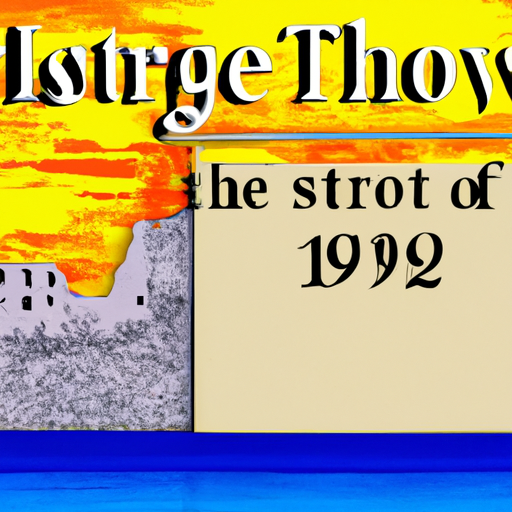Poisoning the Well
Utilizing the past for ill-intent can be a perilous game, with repercussions that can reverberate far into the future. Yet, the temptation to do so remains ever-present and must be resisted.

The past can be a powerful force, one that can be manipulated to serve the needs of certain people or organizations. But, when this is done with malicious intent, the effects can be far-reaching and devastating. It is essential to remember that history should not be abused for personal gain; instead, it should be acknowledged and learned from, so that we may strive for a brighter tomorrow. Let us never forget the lessons of our collective past, and use them to create a better future.
.
Introduction

A person’s argumentation may be subject to a damaging attempt at discrediting, when one individual makes an accusation or assertion about the other’s character or history. This form of logical fallacy is often seen in political debates, where a candidate will try to create a negative view of their rival before the audience even has the chance to hear them out. In this way, they are essentially ‘tainting the well’ and attempting to influence the spectators against their adversary.
– Examining the Historical Roots of Poisoning the Well Fallacy
The concept of poisoning the well has been around for centuries, having its roots in ancient Greece and Rome where political rivals would spread false rumors or fabricate lies about their opponents to discredit them. This trend continued into the 17th century in Britain and 19th century America, where politicians and candidates would use this tactic to gain an advantage. Even now, it is still a common occurrence in political discourse and media coverage, utilized as a way to cast doubt on another’s argument without providing any evidence or facts. Recognizing when one is being subjected to this manipulation can be challenging, yet understanding its history sheds light on why it continues to be used today and how it can be prevented for meaningful dialogue and debate.
– The History of Using Poisoning the Well to Manipulate Public Opinion
For centuries, a tactic of manipulation and propaganda has been used to sway public opinion: poisoning the well. This logical fallacy involves introducing false or irrelevant information into an argument in order to discredit an opposing view or individual. In ancient Greece, influential figures such as politicians and philosophers made use of this technique to gain an advantage in debates or campaigns. The Renaissance period saw its continued use by figures like Martin Luther who sought to spread their beliefs and discredit those who opposed them. As technology advanced, so did the prevalence of this tactic; newspapers were used to spread lies about opponents while radio broadcasts allowed for mass communication of ideas and opinions. Nowadays, social media platforms are often utilized to quickly spread false information through networks of friends or followers, while traditional media outlets like television news programs still employ it frequently. Though unethical in nature, poisoning the well is highly effective at manipulating public opinion and will likely remain a common practice for years to come.
– How Political Elites Have Used Poisoning the Well Throughout History
Throughout the ages, political elites have adopted a strategy of “poisoning the well” to gain an upper hand over their adversaries. This logical fallacy involves one party making negative presumptions about another before they have had a chance to present their arguments. This approach is often used to influence public opinion and give the impression of superiority.
Aristotle discussed this technique in his book Rhetoric, noting that it was an effective way for politicians to manipulate public opinion without engaging with their opponents. For example, during the Peloponnesian War between Athens and Sparta, Athenian politicians sought to discredit Spartan politicians by circulating false information about them.
In more recent times, political elites have continued to employ this tactic in order to gain an advantage over their rivals. During the 2016 U.S presidential election, Donald Trump made accusations against Hillary Clinton before she could present her policies or defend herself against his claims – a move which proved successful in winning over certain voters who may not have been swayed otherwise.
Ultimately, poisoning the well is a powerful tool utilized by political elites throughout history in order to gain an edge over their opponents without actually debating them on policy or other issues. While this technique may be useful in swaying public opinion, it should not be regarded as a legitimate form of discourse as it only serves to spread misinformation and distort facts.
– Exploring Examples of Poisoning the Well in Historical Debates and Discussions
Examining the utilization of poisoning the well in historical discourses and debates is a critical part of comprehending how this informal fallacy has been put to use through the ages. Poisoning the well is a kind of informal fallacy where one endeavors to discredit an opposing argument before it is even given by presenting unfavorable information about the individual making the argument. This could be done by introducing irrelevant facts or opinions about somebody’s character, background, or convictions.
The most punctual known illustration of poisoning the well can be found in old Greek philosophy. Plato’s conversation Gorgias incorporates a section where Socrates utilizes this method against Callicles, a Sophist scholar who contended that morality was subjective. Socrates recommends that Callicles’ perspectives are invalid since he has no genuine information on morality and depends on his own opinion as an alternative.
In more current history, poisoning the well has been utilized in political debates and different sorts of discourse. During the American Revolution, Thomas Paine famously assaulted King George III’s character and strategies in his pamphlet Common Sense. He blamed the ruler for being oppressive and tyrannical and proposed that anybody who upheld him was incorrect too.
Poisoning the well has additionally been utilized in religious debates all through history. During the Reformation time frame, Martin Luther famously used this technique to assault Catholic doctrine by blaming its pioneers for debasement and twofold dealing. By proposing that their contentions were invalid since they were originating from degenerate individuals, Luther looked to discredit Catholicism without really drawing in with their contentions legitimately.
These models show how poisoning the well has been utilized all through history as a way to discredit adversaries without having to draw in with their arguments straightforwardly. It is a devious type of rhetoric that ought to be stayed away from however much as could reasonably be expected if we need to have significant debates about significant points.
– Analyzing the Impact of Poisoning the Well on Historical Events
Throughout the ages, a certain tactic has been employed to discredit opposing arguments and influence public opinion: poisoning the well. This malicious ploy has had an immense influence on many consequential events, from political debates to wars. To comprehend how this technique has been utilized and its implications for our current and future circumstances, it is essential to understand how it has shaped history.
At its core, poisoning the well is a form of manipulation. It involves utilizing preconceived notions and prejudices to sway people away from certain ideas or positions. This can be done through spreading false information, making personal attacks, or simply painting one’s opponents in a negative light. In some cases, this tactic can be used to further political agendas or even start wars.
One example of how poisoning the well impacted history is the Spanish-American War of 1898. During this conflict, U.S. newspapers published stories that portrayed Spain as a cruel oppressor in order to generate public support for American intervention in Cuba – thus creating an atmosphere of distrust and animosity between the two countries which ultimately led to war.
Another example is Nazi Germany’s use of propaganda during World War II. Through radio broadcasts and posters, Nazi leaders were able to spread false information about their enemies and paint them as evil oppressors who needed to be stopped at all costs – enabling Hitler’s regime to remain in power despite its atrocities against humanity.
Poisoning the well continues to be widely used today in politics and media coverage around the world – making it essential that we recognize how this technique can be utilized as a tool for manipulation so that we can make informed decisions moving forward into the future.
conclusion

A logical fallacy that can be potentially hazardous is one in which a person tries to undermine another’s argument by introducing unrelated negative information about them. This could involve assuming something about somebody’s background to invalidate their current thoughts or views. Such a fallacy allows for unsubstantiated claims and misguided judgments without any proof. A disturbing situation indeed!
.
Some questions with answers
Q1. What is poisoning the well?
A1. Poisoning the well is a logical fallacy in which an accuser makes a negative remark about a target before presenting evidence for their argument, thus attempting to discredit the target in advance.
Q2. What kind of fallacy is poisoning the well?
A2. Poisoning the well is a type of informal logical fallacy.
Q3. How can history be used to demonstrate this fallacy?
A3. In history, poisoning the well has been used as a tactic to discredit opposing views or arguments by making false or derogatory statements about them prior to presenting any evidence for those claims.
Q4. Is there any other name for this type of fallacy?
A4. This type of fallacy is also known as “discrediting the source”.
Q5. Are there any examples of this fallacy in current events?
A5. Yes, many politicians and public figures use this tactic today in order to discredit their opponents without providing any evidence or proof for their claims.





